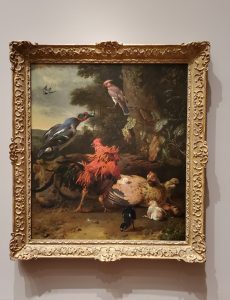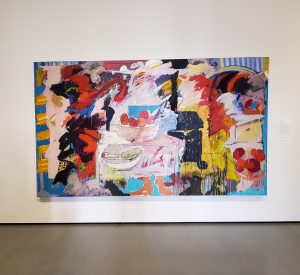By Liam Garrett
The Baltimore Museum of Art is a place that peers and professors have perpetually preached to visit. I have often found myself in the crosshairs of raised eyebrows and expressions of engaged surprise when I divulge I have never been. This consistent pattern of praising recommendation from my professors and the somewhat entertaining eruptions of emotive enthusiasm from friends has led me to visit a place I have never been before, The BMA.
My review would be of their Contemporary Collection which is displaying their Now is The Time exhibition, which is being featured from May 2nd to July 18th . This collection of 22 works are on display with the motive of raising awareness to outstanding art among communities which have been repressed in the past. The highest priority artists in this collection of modern works were artists who were women, black, indigenous, self-trained, or artists who have connections to Baltimore. It was this brief description which I kept in mind as I entered the museum. However, this was immediately forgotten as I witnessed the high ceilings bound by curved walls adorned with slabs of brilliant color upon my entrance. I was taken aback by the beauty of the museum, I must have appeared inebriated to the entrance worker who asked “temperature?” to which I responded “I don’t know it feels like maybe sixty five or something” as I stared at the decorative oak floors. My attention was caught as she remarked “your temperature.”. After adjusting my concentration, I checked in and proceeded up the velvet carpet stairs where an artful living room piece was on display, which faced the staircase witnessing anyone who entered the museum.

I made my way to the Special Collections room through the European art section, This section featured wonderful pieces by great historical artists who painted a variety of subjects, from birds to wonderful landscapes. There were many pieces I spent time experiencing in the European art section, one of which was Birds and Fowl painted by Melchior D Hondecoeter, who was also known by his nickname The Raphael of Bird Painters. I found the composition of this piece to be brilliant and a joy to look at, looking closely reveals the organized array of triangles within the background and foreground delicately and smoothly leading the viewers eye from bird to bird. What was especially interesting about this painting was the illusion created by the expressions on the birds faces. At first glance one may remark that this is a beautifully detailed painting of birds which displays a scene that is reasonable, or even realistic. However in retrospect this scene is an illusion because it applies some sense of humane community values to birds which could never conduct themselves in the way that they are presented. The presentation depicts a duck, who is intruding on a hen with her chicks. The rooster responds with a position of hostility, as another bird watches calm and distanced, avoiding being complicit with the malicious argument between the rooster and the duck. This web of community values and positions is presented in such a way that it is enormously relatable to people, an illusion which is so subtle one may even remark that the painting is a representation of reality instead of what it actually is, the personification of animals.

Dutch, 1636 – 1695 Photo Taken by Liam Garrett
I found this painting to be thought provoking, and the narrative of these thoughts seemed to all revolve around the premise that this painting doesn’t actually represent nature. Although it is beautifully painted with detail and realism the painting underlines something other than our capability for observation and expression. The strokes of oil paint represent a function of our consciousness which applies relative experience to animals, plants, and objects. The truth is that these animals are indifferent to the hierarchy of morals for which we moderate the conduct of our human society. This painting is enormously unbelievable because of this factor. But it is unquestionably believable because it is our default function when perceiving the world to apply relative consciousness often to places where it cannot be applied. For our own security in this strange world, our minds can make it believable that the way we experience and interpret our lives can be universally applied in a tangible way. It is for this reason that the argument for or opposing the genuine existence of good and evil is consistently debated on the philosophical dais. This painting makes the relatable moral structure of our society seem universal in such a relatable way that the painting appears realistic, even if it is not truly believable.

c.1990
However, this depicted quarrel between birds would not prepare me for the contemporary exhibit on display in the special exhibitions section of the gallery. After spending a gigantic amount of time pondering the relative moral structure of roosters, I made my way to the special exhibitions section of the museum and was immediately taken aback by the first piece I saw. It is this piece which caught my eye and stopped my feet for the rest of the duration of my visit. The very large painting, of which had no measurements but was easily ten feet long was named Forbidden Fruit, painted by Mary Lovelace O’Neal. It is a belief of mine that most artwork can be reasonably untangled and dissected in regards composition with enough time, and the emotional motive is a secret which lays in the heart of the artists and the hearts of the viewers to exclusively experience. After spending half an hour viewing this piece, I found myself still more or less absolutely baffled by the compositional choices made in the piece’s construction. This piece is described to represent a figure seated before a bowl of fruit, and the piece was inspired by the work of artists like Paul Cézanne and Henri Matisse. Mary Lovelace O’Neal rejected being categorized as a minimalist artist. I happen to agree with her claim rebuking her minimalist title, although this painting shows great use of broad and freely applied paint there is no doubt that the compositional quality is too observably complex to be considered minimal. The inspiration from Cézanne can be identified immediately towards the center of the piece, in fact it would appear that the triangular central section of this piece is the only part of the piece which presents any notion of somewhat realistic perspective. The color pallete within this section draws inspiration from Cézanne’s period, drawing on muted and deep colors. The application of brush strokes within this section could easily be imagined on an impressionist’s canvas as they are painting, however the brush strokes do not look like that of a completed piece.
The outer perimeter is where the piece becomes baffling, there is so much high energy color, opposing style and directional leading that it becomes impossible to take in the piece as a whole, and the details of the piece simultaneously. What is especially interesting is the level of smoothness that Lovelace was able to produce transitioning from the modernist high energy style to the impressionist style. This transition which was so clean anybody could miss it, and that is what makes this piece incredibly moving for me. My personal interpretation is that this piece embodies the feeling of creative inspiration in our time. Modern values have given the artist more freedom to pursue less traditional means of producing art. This piece embodies the moment artists receive inspiration from other artists. Lovelace is almost giving us a tour of the moment she was inspired by Cézanne’s work. We can see in the central section where she has drawn inspiration from his style and modified it to produce her own unique style in the outer perimeter. This is a very realistic and strong statement about the moment of inspiration, a moment which is fleeting and powerful, moments which are some of the most difficult to reproduce. At the time of viewing this I was listening to Miles Davis’s Flamenco Sketches and I felt myself seeing the sound of his music in my minds eye, this is similar to the experience she has captured. Lovelace has caught the moment of collaboration between imaginations brilliantly.
It was in this moment of realization that the dapper security men told me the museum was closed and kicked me out. The Now is The Time exhibition at the BMA is a thoroughly moving, and wonderful exhibition of voices which have been undermined for decades. The moment I left, was the moment I decided I would go again next week, maybe even every week.